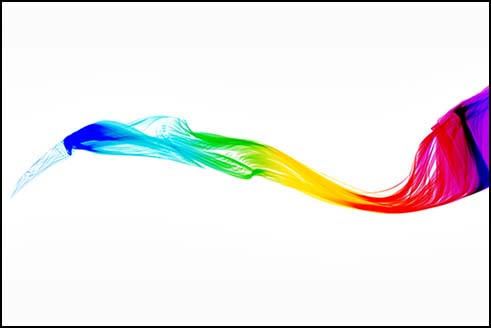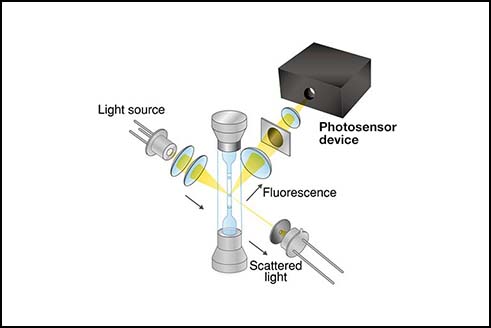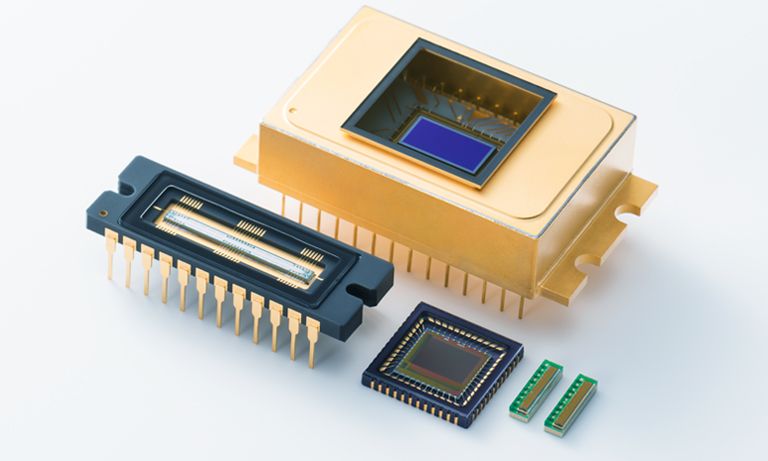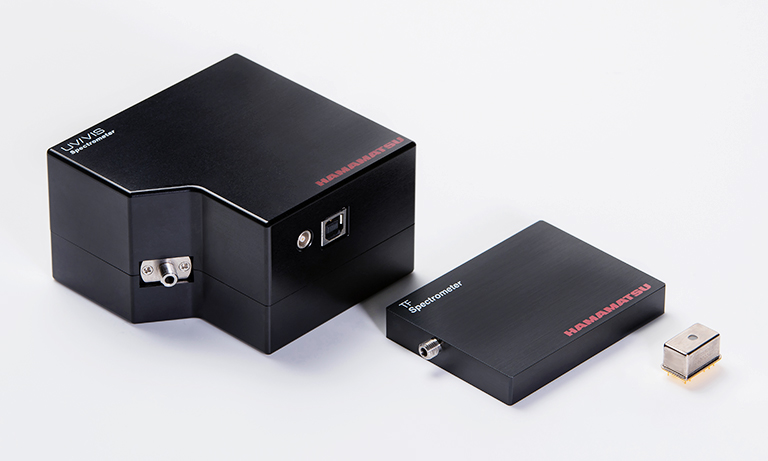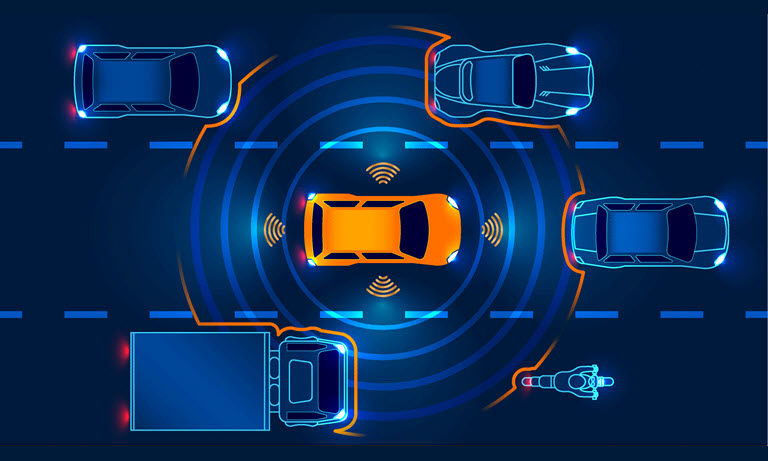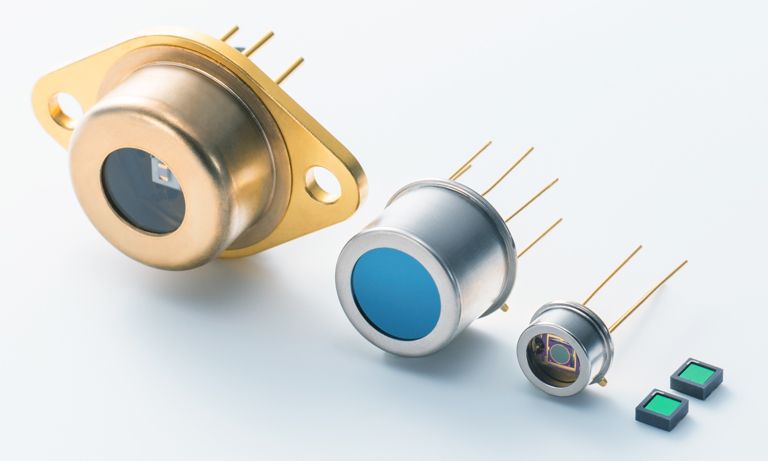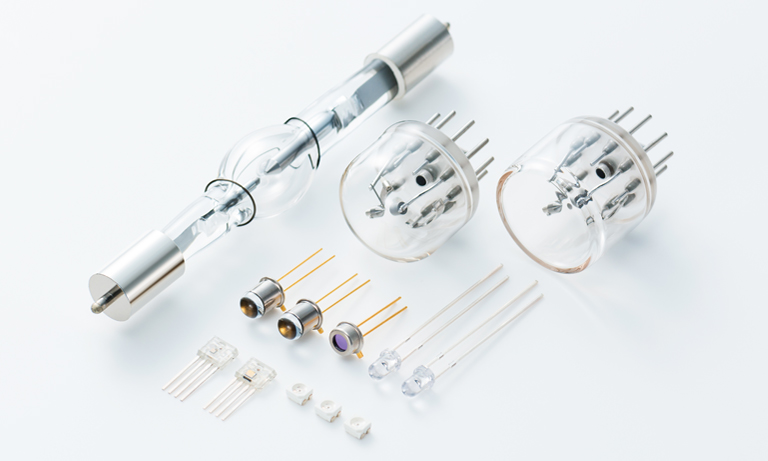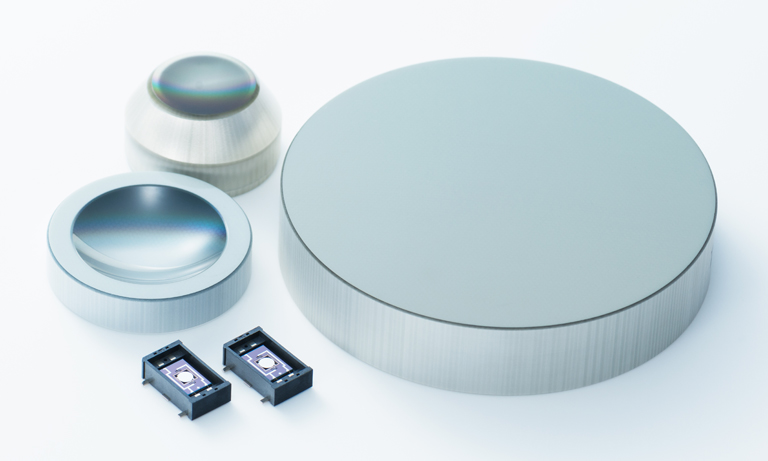Application notes
Technical notes
Ask an engineer
Publications
United States (EN)
Select your region or country.
Quantum Computing and Communication Questions & Answers
- Photonics in Quantum Computing
- What role does photonics play in a trapped ion quantum computer?
- How does photonics play a role in scaling a trapped ion quantum computer?
- What role does photonics play in a neutral atoms quantum computer?
- What role does photonics play in quantum communication?
- Are there other resources for learning more about quantum computing and quantum communication?
Photonics in Quantum Computing
Below we will take a closer look at two qubit modalities, trapped ions and neutral atoms, which heavily use photonic components in their systems and are an active area of research and development as a potential way to realize a fault tolerant quantum computer (FTQC).
What role does photonics play in a trapped ion quantum computer?
Ions operate in an ultra-high vacuum and cryogenic environment inside traps like Penning traps or Paul traps, where electric fields create potentials that confine ions. Below are the photonic components you can typically find in an ion-trapped setup.
■ Lasers: Ion cooling, preparation (ex: optical pumping), reading out, and gate operation.
■ Modulators (ex: AOD, AOM, EOD, DMD, MEMS mirror): Control and direct laser beam at the ions for individual addressing.
■ Optics: Magnify the ions and capture the scattering light for detection.
■ PMT: Measure the fluorescence or lack thereof to indicate the ion’s state.
■ Camera: Image the array or indicate the number of ions in an array, as well as their positioning.
Trapped ion state detection distills down to a histogram that is formed over a measurement time, ranging from several hundred microseconds to a few milliseconds, where photon counts are collected from ions that scatter (bright state) and from ions that do not scatter (dark state). A threshold value of photon counts can be used to distinguish between the bright and dark states with high accuracy [1].

Figure 1. Trapped ions experimental setup

Figure 2. Illustration of photon collection histograms for state detection of a trapped ion
Hamamatsu offers a range of detectors and cameras for ion fluorescence for a variety of ion species:
■ Ytterbium (Yb) at 369 nm
■ Calcium (Ca) at 397 nm
■ Strontium (Sr) at 423 nm
■ Barium (Ba) at 493 nm
We offer a variety of customizations such as UV-enhanced coating for PMTs and special faceplates containing glass partitions to minimize optical crosstalk for multianode PMTs.
Learn more about our offerings for trapped ions.
For more information on customization or on detectors/MEMS mirrors/cameras, please contact us.
How does photonics play a role in scaling a trapped ion quantum computer?
To realize an FTQC that has the ability to solve hard problems, a large number of qubits will be needed. This is where scaling poses some challenges especially for trapped ions. It’s difficult to keep adding ions in a trap. However, there are two proposed scaling architectures for trapped ions that are currently being pursued.
■ Quantum charge-coupled device (QCCD): Chip with a large number of interconnected ion traps where ions are shuttled around either to a region of logic operations or memory region (store quantum information) [2].
■ Network of trapped ion modules: Small ion trapped modules are configured into a network using optical fibers, photonic interconnects, and optical crossconnect switches [3].
Integration is another factor that is often considered when scaling up trapped ions. A trapped ion setup is made up of hundreds of components such as lasers, fibers, bulk optics, cameras, and detectors to name a few. When thinking of building a quantum computer of hundreds of qubits, not all components scale easily such as bulk optics. For ion fluorescence detection, some trapped ion setups use a high-NA UV objective with a large field of view (FOV), but as you scale the objective diameter or FOV ratio, blind spots are produced.
There have been great strides in research for trapped ion integration such as fabricating waveguides, grating couplers [4], and detectors such as single-photon avalanche diode (SPAD) [5] and superconducting nanowire single-photon detector (SNSPD) [6]. Integrating on-chip state readout is attractive for scaling and high collection efficiency [7].
What role does photonics play in a neutral atoms quantum computer?
Neutral atoms operate in a magneto-optical trap (MOT) or ultra-high vacuum cell, and the atoms are confined in arrays with optical tweezers. Below are the photonic components you can typically find in a neutral atoms setup.
■ Lasers: Optical trapping, atom rearrangement, cooling, optical pumping, and gate operations.
■ Modulators:
o LCOS-SLM: Generate optical trap sites.
o AOD: Sort atoms.
o AOM & EOM: Pulse duration, laser intensity.
■ Cameras:
o CCD camera: Image the array.
o EMCCD/sCMOS/qCMOSⓇ: Measure neutral atom’s fluorescence or lack thereof to indicate the atom’s state.
Neutral atom state detection is very similar to trapped ion state detection, where a histogram is constructed over a measurement time, on the order of tens of milliseconds, to distinguish between two states using a threshold derived from the photon counts collected [8].

Figure 3. Neutral atom experimental setup

Figure 4. Illustration of the histogram of photon counts collected from a single neutral atom site
We offer cameras that can measure fluorescence from various neutral atoms like rubidium (Rb), strontium (Sr), ytterbium (Yb), and cesium (Cs).
Learn more about our offerings for trapped ions.
For more information on customization or on detectors/LCOS-SLM/cameras, please contact us.
What role does photonics play in quantum communication?
Quantum key distribution (QKD) is one of the active areas of research and development within quantum communications. QKD is a hardware-based approach that enables two authorized parties, Alice (sender) and Bob (receiver), to establish a secret key at a distance [9]. The secret key is exchanged via photons, and if an eavesdropper were listening in, it would disturb the photon in a measureable way (ex. polarization of photon would change). There are different schemes within QKD such as discrete-variable QKD (DV-QKD), which uses single-photon detectors, and continuous-variable QKD (CV-QKD), which uses homodyne or heterodyne detectors (ex: matched pair of photodiodes) [10].
In DV-QKD the secret key can be generated by a source such as a highly attenuated coherent laser, single-photon source, or entangled photon source [11]. Once a photon travels to the end of a fiber channel, it is detected by a single-photon detector such as a single-photon avalanche diode (SPAD) or a superconducting nanowire single-photon detector (SNSPD).
One of the main challenges of building DV-QKD land networks is the distance limit due to the optical fiber loss. Detector characteristics such as the dark count rate (DCR) for the receiving single-photon detector play a role in setting the maximum transmission distance for quantum information due to the fiber losses.

Figure 5. Illustration of two different QKD schemes: discrete-variable QKD (DV-QKD) and continuous-variable QKD (CV-QKD)
Are there other resources for learning more about quantum computing and quantum communication?
Check out some of our past webinars:
■ Introduction to quantum computer hardware and modalities presented by Prof. William D. Oliver from Massachusetts Institute of Technology (MIT).
■ Photonics in quantum computing and quantum networking presented by Prof. Peter McMahon from Cornell University.
■ Toward global quantum networks presented by Prof. Liang Jiang from University of Chicago.
Another resource is WIRED Magazine’s video on quantum computing, presented by Dr. Talia Gershon.
If you would like to learn about quantum communications on a deeper level, Keio University has produced a playlist titled “Overview in Quantum Communication.” The playlist videos are available in English presented by Dr. Michal Hajdušek and in Japanese presented by Dr. Rodney Van Meter.
References
[1] Bruzewicz, C. D., Chiaverini, J., McConnell, R. & Sage, J. M. Trapped-ion quantum computing: progress and challenges. Appl. Phys. Rev. 6, 021314 (2019).
[2] Kielpinski D, Monroe C and Wineland D J 2002 Architecture for a large-scale ion-trap quantum computer Nature 417 709
[3] Monroe, C. et al. Large-scale modular quantum-computer architecture with atomic memory and photonic interconnects. Phys. Rev. A 89, 022317 (2014).
[4] R. J. Niffenegger, J. Stuart, C. Sorace-Agaskar, D. Kharas, S. Bramhavar, C. D. Bruzewicz, W. Loh, R. T. Maxson, R. McConnell, D. Reens et al., Integrated multi-wavelength control of an ion qubit, Nature 586, 538 (2020).
[5] Reens, D. et al. High-Fidelity Ion State Detection Using Trap-Integrated Avalanche Photodiodes. Phys. Rev. Lett. 129, 100502 (2022).
[6] S. L. Todaro, V. B. Verma, K. C. McCormick, D. T. C. Allcock, R. P. Mirin, D. J. Wineland, S. W. Nam, A. C. Wilson, D. Leibfried, and D. H. Slichter, “State readout of a trapped ion qubit using a trap-integrated superconducting photon detector,” Phys. Rev. Lett. 126, 010501 (2021).
[7] Setzer W, Ivory M, Slobodyan O, Van Der Wall J, Parazzoli L, Stick D, Gehl M, Blain M, Kay R and McGuinness H 2021 Applied Physics Letters 119 154002
[8] Barnes, K., Battaglino, P., Bloom, B.J. et al. Assembly and coherent control of a register of nuclear spin qubits. Nat Commun 13, 2779 (2022). https://doi.org/10.1038/s41467-022-29977-z
[9] M. Krenn, M. Malik, T. Scheidl, R. Ursin, and A. Zeilinger, “Quantum Communication with Photons,” Optics in Our Time, vol. 18, p. 455, 2016.
[10] Lam, P.K. & Ralph, T. Quantum cryptography: Continuous improvement. Nat. Photon. 7, 350 (2013).
[11] T. Hausken et al., “OIDA Quantum Photonics Roadmap,” OSA Industry Development Associates Report, 2020.
If you have a technical question you’d like to see answered on this page, email us.
Meet the engineer

Klea Dhimitri is an applications engineer out of Hamamatsu’s office in Bridgewater, NJ, where she focuses on product offerings for emerging quantum technology applications that utilize photonics. Her expertise includes photodetectors such as photomultiplier tubes (PMT), SPPC (SPAD), MPPC (SiPM), photodiodes, and avalanche photodiodes (APD), as well as their role in quantum applications. Klea leads Hamamatsu's efforts in bringing our R&D from Japan together with researchers and early adopters in North America to provide a range of photonic solutions, from detectors to light modulators to cameras, for the current and future quantum landscape. She also manages Hamamatsu Corporation’s engagement and activities in North American quantum hubs like Chicago Quantum Exchange (CQE). In her spare time, she enjoys endurance-based sports such as running and biking, and is currently training to run her first marathon in the fall.
- Confirmation
-
It looks like you're in the . If this is not your location, please select the correct region or country below.
You're headed to Hamamatsu Photonics website for US (English). If you want to view an other country's site, the optimized information will be provided by selecting options below.
In order to use this website comfortably, we use cookies. For cookie details please see our cookie policy.
- Cookie Policy
-
This website or its third-party tools use cookies, which are necessary to its functioning and required to achieve the purposes illustrated in this cookie policy. By closing the cookie warning banner, scrolling the page, clicking a link or continuing to browse otherwise, you agree to the use of cookies.
Hamamatsu uses cookies in order to enhance your experience on our website and ensure that our website functions.
You can visit this page at any time to learn more about cookies, get the most up to date information on how we use cookies and manage your cookie settings. We will not use cookies for any purpose other than the ones stated, but please note that we reserve the right to update our cookies.
1. What are cookies?
For modern websites to work according to visitor’s expectations, they need to collect certain basic information about visitors. To do this, a site will create small text files which are placed on visitor’s devices (computer or mobile) - these files are known as cookies when you access a website. Cookies are used in order to make websites function and work efficiently. Cookies are uniquely assigned to each visitor and can only be read by a web server in the domain that issued the cookie to the visitor. Cookies cannot be used to run programs or deliver viruses to a visitor’s device.
Cookies do various jobs which make the visitor’s experience of the internet much smoother and more interactive. For instance, cookies are used to remember the visitor’s preferences on sites they visit often, to remember language preference and to help navigate between pages more efficiently. Much, though not all, of the data collected is anonymous, though some of it is designed to detect browsing patterns and approximate geographical location to improve the visitor experience.
Certain type of cookies may require the data subject’s consent before storing them on the computer.
2. What are the different types of cookies?
This website uses two types of cookies:
- First party cookies. For our website, the first party cookies are controlled and maintained by Hamamatsu. No other parties have access to these cookies.
- Third party cookies. These cookies are implemented by organizations outside Hamamatsu. We do not have access to the data in these cookies, but we use these cookies to improve the overall website experience.
3. How do we use cookies?
This website uses cookies for following purposes:
- Certain cookies are necessary for our website to function. These are strictly necessary cookies and are required to enable website access, support navigation or provide relevant content. These cookies direct you to the correct region or country, and support security and ecommerce. Strictly necessary cookies also enforce your privacy preferences. Without these strictly necessary cookies, much of our website will not function.
- Analytics cookies are used to track website usage. This data enables us to improve our website usability, performance and website administration. In our analytics cookies, we do not store any personal identifying information.
- Functionality cookies. These are used to recognize you when you return to our website. This enables us to personalize our content for you, greet you by name and remember your preferences (for example, your choice of language or region).
- These cookies record your visit to our website, the pages you have visited and the links you have followed. We will use this information to make our website and the advertising displayed on it more relevant to your interests. We may also share this information with third parties for this purpose.
Cookies help us help you. Through the use of cookies, we learn what is important to our visitors and we develop and enhance website content and functionality to support your experience. Much of our website can be accessed if cookies are disabled, however certain website functions may not work. And, we believe your current and future visits will be enhanced if cookies are enabled.
4. Which cookies do we use?
There are two ways to manage cookie preferences.
- You can set your cookie preferences on your device or in your browser.
- You can set your cookie preferences at the website level.
If you don’t want to receive cookies, you can modify your browser so that it notifies you when cookies are sent to it or you can refuse cookies altogether. You can also delete cookies that have already been set.
If you wish to restrict or block web browser cookies which are set on your device then you can do this through your browser settings; the Help function within your browser should tell you how. Alternatively, you may wish to visit www.aboutcookies.org, which contains comprehensive information on how to do this on a wide variety of desktop browsers.
5. What are Internet tags and how do we use them with cookies?
Occasionally, we may use internet tags (also known as action tags, single-pixel GIFs, clear GIFs, invisible GIFs and 1-by-1 GIFs) at this site and may deploy these tags/cookies through a third-party advertising partner or a web analytical service partner which may be located and store the respective information (including your IP-address) in a foreign country. These tags/cookies are placed on both online advertisements that bring users to this site and on different pages of this site. We use this technology to measure the visitors' responses to our sites and the effectiveness of our advertising campaigns (including how many times a page is opened and which information is consulted) as well as to evaluate your use of this website. The third-party partner or the web analytical service partner may be able to collect data about visitors to our and other sites because of these internet tags/cookies, may compose reports regarding the website’s activity for us and may provide further services which are related to the use of the website and the internet. They may provide such information to other parties if there is a legal requirement that they do so, or if they hire the other parties to process information on their behalf.
If you would like more information about web tags and cookies associated with on-line advertising or to opt-out of third-party collection of this information, please visit the Network Advertising Initiative website http://www.networkadvertising.org.
6. Analytics and Advertisement Cookies
We use third-party cookies (such as Google Analytics) to track visitors on our website, to get reports about how visitors use the website and to inform, optimize and serve ads based on someone's past visits to our website.
You may opt-out of Google Analytics cookies by the websites provided by Google:
https://tools.google.com/dlpage/gaoptout?hl=en
As provided in this Privacy Policy (Article 5), you can learn more about opt-out cookies by the website provided by Network Advertising Initiative:
http://www.networkadvertising.org
We inform you that in such case you will not be able to wholly use all functions of our website.
Close

